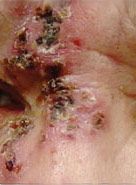- Clinical Technology
- Adult Immunization
- Hepatology
- Pediatric Immunization
- Screening
- Psychiatry
- Allergy
- Women's Health
- Cardiology
- Pediatrics
- Dermatology
- Endocrinology
- Pain Management
- Gastroenterology
- Infectious Disease
- Obesity Medicine
- Rheumatology
- Nephrology
- Neurology
- Pulmonology
Ophthalmic Zoster
Several days earlier, a 69-year-old man had a mild headache, fatigue, and tingling and prickly facial sensations. Shortly afterward, this painful, “weepy” rash developed on his forehead, upper cheek, and nasolabial folds and vision in the right eye became blurry. The patient’s history included type 2 diabetes mellitus, hypertension, and childhood varicella.
Several days earlier, a 69-year-old man had a mild headache, fatigue, and tingling and prickly facial sensations. Shortly afterward, this painful, “weepy” rash developed on his forehead, upper cheek, and nasolabial folds and vision in the right eye became blurry. The patient’s history included type 2 diabetes mellitus, hypertension, and childhood varicella.

The distribution of the multiple swollen, tender, discrete and coalesced, erythematous vesicles and pustules corresponded to the ophthalmic branch of the trigeminal nerve (A). The patient had swollen eyelids and injected conjunctiva (B). Examination of the right eye revealed an edematous cornea with dendrites and anterior chamber inflammation. These findings were consistent with ophthalmic zoster dermatitis.
The risk of varicella reactivation increases with age as immunity wanes; about two-thirds of herpes zoster cases occur in patients 50 years and older.1 Similarly, the rate of zoster-associated complications also increases with age. Most patients with herpes zoster (about 92%) are immunocompetent; the remainder (8%) are immunocompromised because of an underlying condition such as AIDS or active cancer, solid organ transplant, or longterm corticosteroid use.1-3
Postherpetic neuralgia develops in 1 in 4 patients with zoster, and 1 in 10 has other complications.1 Patients with ophthalmic zoster are at increased risk for permanent vision damage if not treated promptly.
Initiation of antiviral therapy within 72 hours of vesiculation accelerates lesion healing, decreases acute pain duration, and may reduce the risk of postherpetic neuralgia. To avoid spreading the virus, patients should be advised not to touch active lesions. Herpes zoster vaccination is also recommended for persons 60 years and older.4 Its administration should be deferred in patients with acute illness, such as in the presence of fever or active tuberculosis.

This patient was treated with systemic acyclovir and trifluridine ophthalmic solution as well as prednisone and an analgesic to help relieve symptoms. Wound cultures confirmed the presence of varicella-zoster virus, as well as a secondary staphylococcal infection, which was treated with an antibiotic. At follow-up, the patient’s rash had resolved and his vision had improved. He had no signs of postherpetic neuralgia. The patient also received the zoster vaccine.
References:
REFERENCES:
1.
Yawn BP, Saddier P, Wollan PC, et al. A populationbased study of the incidence and complication rates of herpes zoster before zoster vaccine introduction [published correction appears in Mayo Clin Proc. 2008;83:255]. Mayo Clin Proc. 2007;82:1341-1349.
2.
Ragozzino MW, Melton LJ 3rd, Kurland LT, et al. Population-based study of herpes zoster and its sequelae. Medicine (Baltimore). 1982;61:310-316.
3.
Donahue JG, Choo PW, Manson JE, Platt R. The incidence of herpes zoster. Arch Intern Med. 1995; 155:1605-1609.
4.
Kimberlin DW, Whitley RJ. Varicella-zoster vaccine for the prevention of herpes zoster. N Engl J Med. 2007;356:1338-1343.
